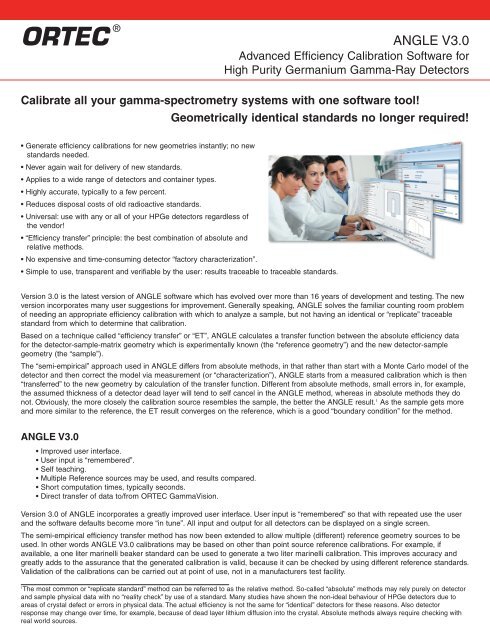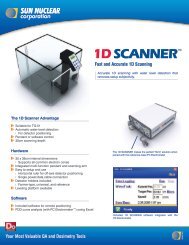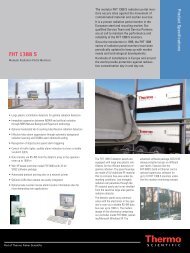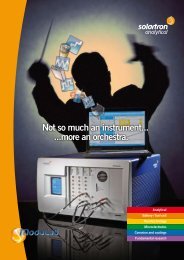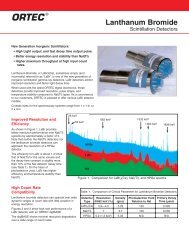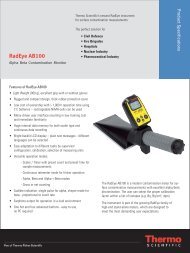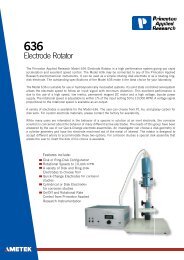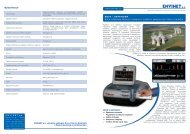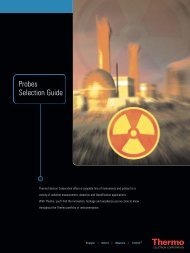ANGLE V3.0 - Envinet a.s.
ANGLE V3.0 - Envinet a.s.
ANGLE V3.0 - Envinet a.s.
- No tags were found...
You also want an ePaper? Increase the reach of your titles
YUMPU automatically turns print PDFs into web optimized ePapers that Google loves.
ORTEC ® <strong>ANGLE</strong> <strong>V3.0</strong>Advanced Efficiency Calibration Software forHigh Purity Germanium Gamma-Ray DetectorsCalibrate all your gamma-spectrometry systems with one software tool!Geometrically identical standards no longer required!• Generate efficiency calibrations for new geometries instantly; no newstandards needed.• Never again wait for delivery of new standards.• Applies to a wide range of detectors and container types.• Highly accurate, typically to a few percent.• Reduces disposal costs of old radioactive standards.• Universal: use with any or all of your HPGe detectors regardless ofthe vendor!• “Efficiency transfer” principle: the best combination of absolute andrelative methods.• No expensive and time-consuming detector “factory characterization”.• Simple to use, transparent and verifiable by the user: results traceable to traceable standards.Version 3.0 is the latest version of <strong>ANGLE</strong> software which has evolved over more than 16 years of development and testing. The newversion incorporates many user suggestions for improvement. Generally speaking, <strong>ANGLE</strong> solves the familiar counting room problemof needing an appropriate efficiency calibration with which to analyze a sample, but not having an identical or “replicate” traceablestandard from which to determine that calibration.Based on a technique called “efficiency transfer” or “ET”, <strong>ANGLE</strong> calculates a transfer function between the absolute efficiency datafor the detector-sample-matrix geometry which is experimentally known (the “reference geometry”) and the new detector-samplegeometry (the “sample”).The “semi-empirical” approach used in <strong>ANGLE</strong> differs from absolute methods, in that rather than start with a Monte Carlo model of thedetector and then correct the model via measurement (or “characterization”), <strong>ANGLE</strong> starts from a measured calibration which is then“transferred” to the new geometry by calculation of the transfer function. Different from absolute methods, small errors in, for example,the assumed thickness of a detector dead layer will tend to self cancel in the <strong>ANGLE</strong> method, whereas in absolute methods they donot. Obviously, the more closely the calibration source resembles the sample, the better the <strong>ANGLE</strong> result. 1 As the sample gets moreand more similar to the reference, the ET result converges on the reference, which is a good “boundary condition” for the method.<strong>ANGLE</strong> <strong>V3.0</strong>• Improved user interface.• User input is “remembered”.• Self teaching.• Multiple Reference sources may be used, and results compared.• Short computation times, typically seconds.• Direct transfer of data to/from ORTEC GammaVision.Version 3.0 of <strong>ANGLE</strong> incorporates a greatly improved user interface. User input is “remembered” so that with repeated use the userand the software defaults become more “in tune”. All input and output for all detectors can be displayed on a single screen.The semi-empirical efficiency transfer method has now been extended to allow multiple (different) reference geometry sources to beused. In other words <strong>ANGLE</strong> <strong>V3.0</strong> calibrations may be based on other than point source reference calibrations. For example, ifavailable, a one liter marinelli beaker standard can be used to generate a two liter marinelli calibration. This improves accuracy andgreatly adds to the assurance that the generated calibration is valid, because it can be checked by using different reference standards.Validation of the calibrations can be carried out at point of use, not in a manufacturers test facility.1The most common or “replicate standard” method can be referred to as the relative method. So-called “absolute” methods may rely purely on detectorand sample physical data with no “reality check” by use of a standard. Many studies have shown the non-ideal behaviour of HPGe detectors due toareas of crystal defect or errors in physical data. The actual efficiency is not the same for “identical” detectors for these reasons. Also detectorresponse may change over time, for example, because of dead layer lithium diffusion into the crystal. Absolute methods always require checking withreal world sources.
<strong>ANGLE</strong> <strong>V3.0</strong>Advanced Efficiency Calibration Software forHigh Purity Germanium Gamma-Ray Detectors<strong>ANGLE</strong> <strong>V3.0</strong> in UseThe main window is clear, informative and logicallyorganized into five groups.In order to explain these five groupings, a step-bystepexplanation of how to set up <strong>ANGLE</strong> <strong>V3.0</strong> andgenerate a calibration follows. Most typically, some ofthe data (for example, data on a specific detector, oron a source container) will already have beenentered previously, so that there may be fewer stepsrequired than actually given here.Step 1Entry of Detector data.Detector templates are supplied ready to take thephysical data for the detector in use. The followingGermanium detector types are supported:• Closed end coaxial HPGe• True coaxial HPGe• Closed end coaxial Ge(Li)• Open end coaxial Ge(Li)• Planar (GLP)• GWL (well type)Usually the data for the specific detectors on thesystem will already be present. This is a one timeonly exercise.Steps 2, 3 and 4 which follow are completed once forthe reference: container-geometry-source and oncefor the “sample”: container-geometry-source,(“sample” is the unknown efficiency being calculated).First the reference data are entered and saved andthen the sample data are entered. Once thereference data are entered and saved, further samplegeometries are calculated as needed. <strong>ANGLE</strong>supports unlimited numbers of reference and samplegeometries.2
<strong>ANGLE</strong> <strong>V3.0</strong>Advanced Efficiency Calibration Software forHigh Purity Germanium Gamma-Ray DetectorsStep 2Entry of Container data.Container templates exist for Cylindrical and Marinelliconfigurations, and the “no container” option can dealwith point sources or filters. The Cylindrical can also beused for Point (or quasi-point) and disc (or quasi-disc,e.g. air filters) sources by entering height and/or radiusas zero.Step 3Entry of Geometry information.The Geometry information screen also utilizes thegraphical display to make data entry simple. <strong>ANGLE</strong><strong>V3.0</strong> includes materials databases to make data entrysimple. Up to five layers of intercepting absorbingmaterial can be included.Step 4Entry of Source information.The source is defined by its height, radius andmaterial. Height and radius can be changed by simplyclicking the appropriate option in Source group in themain <strong>ANGLE</strong> window and entering the new value.Steps 2, 3, and 4 are carried out first for the reference,and the data saved and then repeated for the sample.Step 5Creation of Reference Efficiency data. (“Other” windowon main screen).Here the efficiency data points (experimental values)and the relevant detector, reference container,reference source, and reference geometry arecombined. The measured reference efficiency pointsare easily imported from GammaVision by a singlemouse click.3
<strong>ANGLE</strong> <strong>V3.0</strong>Advanced Efficiency Calibration Software forHigh Purity Germanium Gamma-Ray DetectorsStep 6Calculating the new Sample calibration.Clicking the “from current data set” item will result inthe efficiency curve data entered about the referencestandard being “adjusted” to reflect the parametersentered for the sample geometry.The new calibration may then be exported to GammaVision. . . it’s that simple!AccuracyThe method, which is referred to as a “semi empirical” method, is highly accurate because it is based on experimentally determinedreference geometry data. The calibration accuracy is limited by the accuracy to which the physical data for the sample and thedetector are known, given the condition that a reliable source of accurately known activity is used for the reference.There are many factors that can affect the accuracy of the results. However, with the correct entry of the information about thedetector, container, geometry and source, and with a reliable reference calibration source, routine applications can expect 3–4%accuracy.4
<strong>ANGLE</strong> <strong>V3.0</strong>Advanced Efficiency Calibration Software forHigh Purity Germanium Gamma-Ray Detectors<strong>ANGLE</strong> Simplified Methodology<strong>ANGLE</strong> relies on the concept of “Effective Solid <strong>ANGLE</strong>”: The absolute detector crystal photopeak efficiency for the sample ε p isrelated to that for a reference standard ε p,ref by:ε Ω⎯p = ε p,ref -----------Ω⎯ refWhere the Ω⎯ factors are the “effective solid angle” factors for sample and reference (“ref”). The effective solid angle is a “catch-all” termwhich takes account of sample/reference geometry, and gamma attenuation in all intercepting layers between radionuclide and activedetector crystal, in the sample and in the detector itself. If ε p,ref is obtained by a calibration measurement of the reference source andthe Ω⎯ factors are calculable from the physical data of detector, reference and sample, ε p may be calculated and be used to determinethe actual activities in the sample.Determination of the Ω⎯ effective solid angle factors for reference and sample are the challenge!Below is an example of the mathematics applicable to a Marinelli geometry.<strong>ANGLE</strong> <strong>V3.0</strong> “protects” the user from the complexity of these calculations making efficiency transfer calculations simple to performthrough its user-friendly graphical user interface.PrerequisitesWindows 2000/XP/Vista.Detailed detector dimensional and material information. (Contact the detector manufacturer.)Detailed container dimensional and material information. (Contact the container manufacturer.)Ordering InformationModelDescription<strong>ANGLE</strong>-B32 Advanced Efficiency Calibration software for HPGe detectors.<strong>ANGLE</strong>-G32 Documentation for <strong>ANGLE</strong>-B32.<strong>ANGLE</strong>-U32 Update for <strong>ANGLE</strong>-B32.5
<strong>ANGLE</strong> <strong>V3.0</strong>Advanced Efficiency Calibration Software forHigh Purity Germanium Gamma-Ray DetectorsReferencesReferences 1 and 2 are highly recommended to the interested reader.1. <strong>ANGLE</strong> v2.1 — New version of the computer code for semiconductor detector gamma-efficiency calculations, S. Jovanovic, A.Dlabac and N. Mihaljevic, Nuclear Instruments and Methods in Physics Research Section A, doi:10.1016/j.nima.2010.02.058.2. Testing efficiency transfer codes for equivalence, T. Vidmar, N. Çelik, N. Cornejo Díaz, A. Dlabac, I.O.B. Ewa, J.A. CarrazanaGonzález, M. Hult1, S. Jovanović, M.C. Lépy, N. Mihaljević, O. Sima, F. Tzika, M. Jurado Vargas, T. Vasilopoulou and G. Vidmar,Applied Radiation and Isotopes, Volume 68, Issue 2, February 2010, Pages 355-359.3. Reliability of two calculation codes for efficiency calibrations of HPGe detectors, K. Abbas, F. Simonelli, F. D’Alberti, M. Forte andM. F. Stroosnijder, Applied Radiation and Isotopes, Volume 56, Issue 5, May 2002, Pages 703-709.4. Methods and software for predicting germanium detector absolute full-energy peak efficiencies, K. R. Jackman and S. R.Biegalski, Journal of Radioanalytical and Nuclear Chemistry, Volume 279, Number 1/January, 2009, Pages 355-360.5. Calculation of the absolute peak efficiency of gamma-ray detectors for different counting geometries, L. Moens, J. De Donder, LinXi-lei, F. De Corte, A. De Wispelaere, A. Simonits and J. Hoste, Nuclear Instruments and Methods in Physics Research, Volume187, Issues 2-3, 15 August 1981, Pages 451-472.6. Calculation of the peak efficiency of high-purity germanium detectors, L. Moens and J. Hoste, The International Journal of AppliedRadiation and Isotopes, Volume 34, Issue 8, August 1983, Pages 1085-1095.7. <strong>ANGLE</strong>: A PC-code for semiconductor detector efficiency calculations, S. Jovanović, A. Dlabač, N. Mihaljević and P. Vukotić,Journal of Radioanalytical and Nuclear Chemistry, Volume 218, Number 1/April, 1997, Pages 13-20.8. On the applicability of the effective solid angle concept in activity determination of large cylindrical sources, P. Vukotić, N.Mihaljević, S. Jovanović, S. Dapčević, and F. Boreli, Journal of Radioanalytical and Nuclear Chemistry, Volume 218, Number1/April, 1997, Pages 21-26.9. "EXTS<strong>ANGLE</strong>" — An extension of the efficiency conversion program "SOLANG" to sources with a diameter larger than that of theGe-detector, N. Mihaljević, S. Jovanović, F. De Corte, B. Smodiš, R. Jaćimović, G. Medin, A. De Wispelaere, P. Vukotić and P.Stegnar, Journal of Radioanalytical and Nuclear Chemistry, Volume 169, Number 1/March, 1993, Pages 209-218.10. Introduction of Marinelli effective solid angles for correcting the calibration of NaI(Tl) field gamma-ray spectrometry in TL/OSLdating, F. De Corte, S. M. Hossain, S. Jovanović, A. Dlabač, A. De Wispelaere, D. Vandenberghe and P. Van den Haute, Journal ofRadioanalytical and Nuclear Chemistry, Volume 257, Number 3/September, 2003, Pages 551-555.11. Contribution of 210Pb bremsstrahlung to the background of lead shielded gamma spectrometers, D. Mrđa, I. Bikit, M. Veskovićand S. Forkapić, Nuclear Instruments and Methods in Physics Research Section A, Volume 572, Issue 2, 11 March 2007, Pages739-744.12. Production of X-rays by cosmic-ray muons in heavily shielded gamma-ray spectrometers, I. Bikit, D. Mrda, I. Anicin, M. Veskovic, J.Slivka, M. Krmar, N. Todorovic and S. Forkapic, Nuclear Instruments and Methods in Physics Research Section A, Volume 606,Issue 3, 21 July 2009, Pages 495-500.6
<strong>ANGLE</strong> <strong>V3.0</strong>Advanced Efficiency Calibration Software forHigh Purity Germanium Gamma-Ray Detectors7
<strong>ANGLE</strong> <strong>V3.0</strong>Advanced Efficiency Calibration Software forHigh Purity Germanium Gamma-Ray DetectorsORTEC®www.ortec-online.comTel. (865) 482-4411 • Fax (865) 483-0396 • ortec.info@ametek.com801 South Illinois Ave., Oak Ridge, TN 37831-0895 U.S.A.For International Office Locations, Visit Our WebsiteSpecifications subject to change081810


